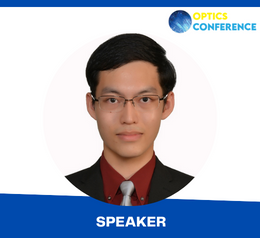Scholars 2nd Edition International Conference on
Optics, Lasers and Photonics
THEME: "A New Era towards Optics, Lasers & Photonics Technologies"
 27-28 Mar 2023
27-28 Mar 2023  Crowne Plaza Ealing, London, UK & Online
Crowne Plaza Ealing, London, UK & Online THEME: "A New Era towards Optics, Lasers & Photonics Technologies"
 27-28 Mar 2023
27-28 Mar 2023  Crowne Plaza Ealing, London, UK & Online
Crowne Plaza Ealing, London, UK & Online 
University Sains Malaysia, Penang, Malaysia
Title: Numerical Assessment of Horizontal Scanning LIDAR Performance via Comparative Study Method (published in Optics and Lasers in Engineering)
Joseph Boon Han, Ooi received his B.Sc. (Hons.) degree in Natural Sciences (Physical) from the University of Cambridge, United Kingdom in 2021, specialising in Physics. He is currently pursuing the Ph.D. in Physics degree at University Saints Malaysia, Penang, Malaysia on a fast-track programmer. His research focuses on the development of a low-cost LIDAR for atmospheric aerosol detection.
LIDAR performance is often evaluated after assembled prototypes are deployed for field tests. However, this approach is resource-intensive, which necessitates more cost-effective ways to detect flaws and improve LIDAR design. In this work, we present numerical assessment of horizontal scanning LIDAR performance via comparative study method. This assessment method could evaluate LIDAR performance without physically assembling the unit, hence save resources and time. We demonstrate this using a hypothetical atmospheric LIDAR. In our assessment, Python™ was used to develop simulation algorithm based on LIDAR equation, while Koschmieder visibility theory was used in atmosphere modeling. Daytime visibility and MODTRAN® solar spectral radiance data were also incorporated for analysis. We then evaluated LIDAR performance based on signal-to-noise and range-corrected signal profiles. Lastly, we conducted comparative study of this hypothetical LIDAR setup with Shiina (light emitting diode) LIDAR and VAST (ground-based) LIDAR for horizontal distance of 1 km. Numerical analysis showed that hypothetical LIDAR could operate up to 1 km at night. During daytime, detection was limited to 94 m and 220 m for 532 nm and 808 nm channels respectively. Comparative study demonstrated that the hypothetical LIDAR excelled in nighttime detection range with acceptable daytime performance. Overall, the hypothetical LIDAR has met case study requirements. We demonstrate the feasibility of this numerical assessment via comparative study method by identifying possible improvements in laser module without experimental data verification. (DOI: 10.1016/j.optlaseng.2022.107267)